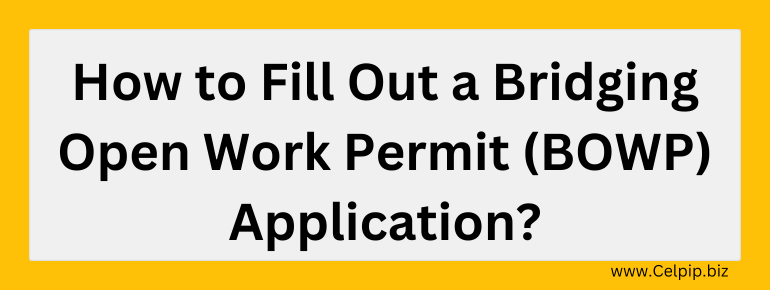How to Fill Out a Bridging Open Work Permit Application?: The Bridging Open Work Permit (BOWP) lets a worker stay in Canada while Immigration, Refugees, and Citizenship Canada (IRCC) processes his or her application for permanent residence.
Canada has the BOWP to help the people who will move to Canada in the future get ready for life there. This CanadaVisa page has a lot of information about how to get a BOWP.
The Bridging Open Work Permit (BOWP) is a way for a foreigner in Canada to keep working while his or her application for permanent residence is being processed.
In-Canada applicants who have applied for permanent residence under one of the eligible economic immigration programs may be eligible for a BOWP if they already have a valid work permit, have kept their status and permission to work by submitting an application to renew their work permit, or are eligible to restore their temporary resident status with permission to work on a work permit.
A foreign worker who is officially working in Canada and has applied for permanent residence through one of the following economic immigration programs can keep working until a decision is made on his or her application:
- Federal Skilled Worker Program
- Canadian Experience Class
- Federal Skilled Trades Program
- Provincial Nominee Program
- Quebec Skilled Workers
- Agri-Food Pilot Program
This is good for the federal government, Canadian communities, and employers, as well as applicants and their families. If this wasn’t the case, applicants and their dependents (spouse and children) would have to leave Canada temporarily, stay in Canada as visitors, or find an employer willing to go through the process of applying for a Labour Market Impact Assessment (LMIA).
An open work permit, which lets the holder work for any employer in Canada, is better because it gives applicants more freedom to integrate and find their way around the Canadian job market. This is especially true if they have already been approved for permanent residence and are already working in Canada.
Who can get “Bridging Open Work Permits”?
To get a BOWP, you must meet the following requirements:
- The foreigner is currently in Canada because he or she was given permission to live there temporarily;
- The foreign national:
- has a work permit that is still good, OR
- has kept their position and right to work in Canada under section 186(u) of the Immigration and Refugee Protection Regulations (IRPR) because they submitted an application to renew their work permit under subsection R201(1), OR
- Is qualified to get their temporary resident status back and get a work permit so they can work.
- Have turned in an Application for Permanent Residence (APR) as the main candidate for one of the following programs:
- The Federal Skilled Worker Program
- The Canadian Experience Class
- The Federal Skilled Trades Program
- The Provincial Nominee Program
- The Quebec Skilled Workers
- Pilot Program for Agri-Food
- Care for People with High Medical Needs Class or Care for Children Class (before June 18, 2019).
- Have finished one of the following APR stages, based on the program they are applying to:
- Under Section 10 of the Immigration and Refugee Protection Regulations, the electronic application for permanent residence sent through Express Entry has passed the check for completion.
- The APR for the Quebec Skilled Worker Program passed the check for completion in Section 10 of the IRPR.
- Receiving a good eligibility assessment on their APR that was sent by mail or online under the Caring for Children Class, Caring for People with High Medical Needs Class, Agri-Food Pilot, or non-Express Entry PNP stream.
Spouse or common-law partner and dependents:
The person with a BOWP must meet certain requirements for his or her spouse to also be qualified for an open work permit:
- Holds a current work permit or is allowed to work in Canada without a work permit under Section 186(w) of the IRPR
- Is allowed to work in Canada for at least six months after the application for a spouse’s open work permit is accepted.
- Is used in one of these ways:
- A job that fits into the National Occupational Classification (NOC) Levels 0, A, or B in a skill
- An application for a NOC 0, A, B, or C under the Atlantic Immigration Policy
- A provincial nomination license and can work in any job.
- Owns a Quebec Selection Certificate and can do any job.
- Is physically living in Canada or has plans to live there while working
- Is in a real relationship with their partner, whether they live together or not.
Children who depend on their parents cannot get an open work permit. To be able to apply for a work permit, they must get a Labour Market Impact Assessment (LMIA) or have a situation that exempts them from getting an LMIA.
The Employment Location
When it comes to where certain people want to work, IRCC has the following rules:
PNP
When a Provincial Nominee Program (PNP) permanent resident applicant requests a BOWP, the work place on the work permit must be limited to the nominating province. So, you have to choose the province of the destination and then the city of the destination to show the province/territory.
Province of Quebec
When giving a BOWP to a permanent resident applicant who Quebec has chosen as a skilled worker, Quebec must be chosen as the place of employment on the work permit.
Summary:
- Work while applying for PR
- Spousal open work permits
- Child work permits
- Location restrictions
- Validity tied to PR
- Employer switch allowed
- Travel with documentation
FAQS on Open Work Permit
1. What is a Bridging Open Work Permit (BOWP)?
A Bridging Open Work Permit (BOWP) is a type of work permit in Canada that allows foreign workers who have applied for permanent residence to continue working while their application is being processed.
2. Who is eligible for a BOWP?
To be eligible for a BOWP, you must meet certain requirements, including:
- Being in Canada with temporary resident status.
- Having a valid work permit or having maintained your status and work authorization by applying to renew your work permit.
- Applying for permanent residence through one of the eligible economic immigration programs.
- Reaching specific stages in the permanent residence application process based on the program you’re applying to.
3. Which immigration programs qualify for a BOWP?
Several economic immigration programs qualify for a BOWP, including
- Federal Skilled Worker Program
- Canadian Experience Class
- Federal Skilled Trades Program
- Provincial Nominee Program
- Quebec Skilled Workers
- Agri-Food Pilot Program
- Care for People with High Medical Needs Class or Care for Children Class (before June 18, 2019).
4. Can spouses and dependents of BOWP holders also get open work permits?
Yes, spouses and common-law partners of BOWP holders may be eligible for open work permits if they meet certain criteria, including holding a current work permit, having the ability to work in Canada for at least six months, and meeting specific job and residency requirements.
5. Can children of BOWP holders obtain open work permits?
Children who depend on their parents cannot obtain open work permits. They would typically need to go through the process of obtaining a Labour Market Impact Assessment (LMIA) or meeting specific exemptions to work in Canada.
6. Are there location restrictions for BOWP holders?
Yes, there are location restrictions for some BOWP holders:
- Provincial Nominee Program (PNP) applicants must work in the nominating province.
- Quebec-selected skilled workers must work in Quebec.
7. How long is a BOWP valid for?
The validity of a BOWP depends on the stage of your permanent residence application. Typically, it remains valid until a decision is made on your application.
8. How do I apply for a BOWP?
To apply for a BOWP, you should follow the application instructions provided by Immigration, Refugees, and Citizenship Canada (IRCC). This often involves submitting the required forms, and supporting documents, and paying the necessary fees.
9. Can I switch employers with a BOWP?
Yes, BOWP holders can work for any employer in Canada, as it is an open work permit, which provides flexibility in choosing employment.
10. Can I travel outside Canada while holding a BOWP?
Yes, you can travel outside Canada while holding a BOWP. However, you should ensure that you meet all the requirements for re-entry into Canada, including a valid passport, visa (if required), and a valid BOWP.






